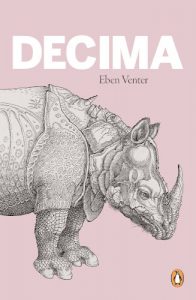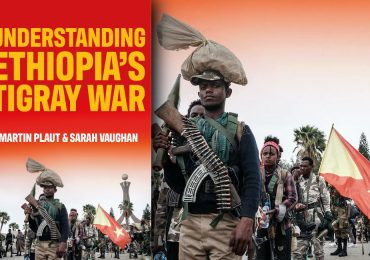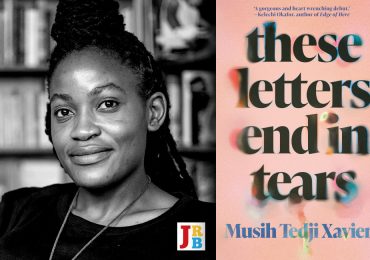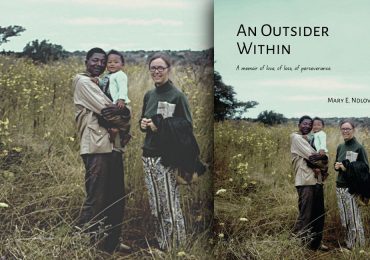Eben Venter’s Decima is a novel in which morality is shown to be an intricately woven fabric of contesting needs and hopes, writes Michael Titlestad.
Note: this review contains spoilers.

Decima
Eben Venter
Penguin Random House, 2023
The titular protagonist of Decima is a rhino, specifically: ‘Diceros bicornis, as Carl Linnaeus named the black rhinoceros in his Systema Naturae, in 1758’. When she was a calf, forty years before the novel begins, her mother was poached for her horn in the Kruger National Park. Refusing to leave her mother’s body, a plaintive Decima was airlifted to safety by game rangers and homed in the Great Fish River Reserve in the Eastern Cape. It is around her embodied individual and social life, described in loving detail by the narrator, that the novel coheres.
Eben Venter, the author of nine critically acclaimed novels, four of which have been translated into English—My Beautiful Death, Trencherman, Wolf, Wolf and Green as the Sky Is Blue—has won a number of illustrious literary awards, including four Media24 Literary Awards, the WA Hofmeyr Prize and the KykNet-Rapport Prize. Decima is the first novel he composed in English and then translated into Afrikaans.
Decima is a singular and significant work. The primary narrative concerns the narrator’s journey into the precarious life of Decima, and her historical, political and economic context. Events unfold during a return visit to his homeland, South Africa (he lives in Lismore, Australia), to continue his research into the lives of rhinoceroses and the poaching that is edging them towards extinction. He is also visiting his ageing mother. Readers will inevitably wonder whether the narrator is Eben Venter, for the details of their lives correspond, and the book itself is clearly the outcome of the investigations it describes. Asked this question in a public conversation, Venter suggested that, in writing Decima, he had made little effort to keep author and narrator apart.
If pressed for a definition of the work’s genre, which seems to me somewhat pointless in relation to such an artfully constructed contrivance of meaning in different modes, I would answer the novel comprises literary elements, autofiction and narrative non-fiction. Decima herself is imagined into being, as are two poachers; the pair of Queensland University researchers who travel to Hong Kong to research the use of rhinoceros horn in Traditional Chinese Medicine (TCM); and Ziyanda Nelson, a game warden.
The novel opens with the narrator (and his guide, Thulani Lani Klaas) visiting Nolala, a sangoma (more correctly, the narrator points out, an igqirha) in Motherwell, the oldest and one of the most impoverished townships in the Eastern Cape. He is seeking to discover the manner of guidance she offers rhinoceros poachers planning to enter the Great Fish River Reserve. The visit is fraught with linguistic and cultural difference, but when Nolala sends him a text message later in the novel, we see that she is torn between offering ritual protection to poachers planning an incursion and discouraging them from their bloody onslaught. Nothing in Decima is Manichean: morality is shown to be an intricately woven fabric of contesting needs and hopes.
We follow the narrator in his journey of research, which slips timeframes. He shares with us the story of the first rhinoceros taken to Europe. Captured in 1515 in the Terai–Duar grasslands at the foot on the Himalayas, she was led to Khambat (Gujarat), traded via Goa to the Portuguese, and sketched by Albrecht Dürer (the sketch appears on the cover of Decima). The rhinoceros was intended as a gift to Pope Leo X, but the ship in which she was being taken to the Vatican capsized off Cabo de Sāo Vicente, and she drowned. Venter’s description of the dying animal is hauntingly poignant.
We accompany the narrator on a visit to Koninklijk Museum in Brussels, in which are still housed remnants of the elephant genocide in the Congo Free State, when it was ruled by King Leopold II (it is estimated that around 190,400 elephants were slaughtered by ivory trading companies). It is noted that the king also sanctioned the mutilation of co-opted workers in the rubber plantations if they did not reach their daily quota. Later, the narrator describes the African hunting trips by John Alexander Hunter (in Kenya between 1944–1947), whose inventory casually lists the killing of 996 rhinoceros, and the bloody swathe cut through East Africa by Franklin D Roosevelt and his son, Kermit. The narrator sums up the president’s expeditions: ‘Mister Roosevelt. Dead now, dead then.’
Decima’s life is adjacent to this history of slaughter—this inhuman objectification of animals, hunted for money or white masculine pride. The threat she faces is the unfolding genocide of the rhinoceros: being shot by poachers for their horns.
The novel unfolds between the last day of the new moon until the full moon is on the rise—when poachers are most active. We are told in detail about the wretched lives and desperate financial circumstances of two opportunistic poachers, Athule Bomvana and Frankie van der Merwe, who meet coincidentally at a petrol station in Stamford. This is their first—and likely only—poaching mission. They are a far cry from the ex- or paramilitary poachers deployed by the larger syndicates. Venter humanises Athule and Frankie. They are hesitant and afraid. Before they can cut the fence, find and murder Decima and hack off her horn, they both smoke tik (methamphetamine)—without shifting their minds, the act is inconceivable.
In some ways, academics come off worse than poachers in Decima. Roslyn Lung and Leigh-Ann Biggs, two University of Queensland researchers into TCM, travel from Brisbane to Hong Kong. They are subsidised sleuths researching the use of rhinoceros horn by TCM practitioners. They prove to be naïve and bicker about deviating from academic register and protocols in the paper they are co-authoring.
Roslyn, who stays on in Hong Kong after Leigh-Ann has left, insinuates her way into a TCM practice, is eventually permitted to see shavings of horn, and—just as she is about to leave—erupts:
She takes out her notebook again and pulls a photograph of a slain rhinoceros from its rear pouch. The rhino is lying on its right side, its head lifted and steadied on a pile of rocks to make it easier to hack off the two horns. She can hardly look at it.
With both hands she shoves the photograph into the face of the man, her hands shaking. In order to steady them, she flattens the photograph on the counter. This is where your horn comes from, she says.
He grabs the stone pestle and waves it at her. Get out, he says, his eyes shot with jet.
The narrator sums up the futility of her action and their research—ushering them unceremoniously out of the novel:
Their work done, the two Hong Kong researchers will not feature again. As for their article, it will go nowhere: at most, an addition to a digital library; if lucky, it will be accessed by a handful of other academics, all locked up in their stuffy, closed-in worlds. In all likelihood, the article will have no effect on the activities or beliefs of the various players in the rhino game. As my mother would say: it means boggerol.
The fourth narrator in the novel is Ziyanda Nelson, a ranger who oversees the southern part of the Great Fish River Reserve. Her anxiety heightens as the full moon approaches—she knows the rhinoceroses she cares for (protects and loves) are in increasing danger. She sees on the monitor in the game wardens’ cabin a flash of Athule and Frankie approaching Decima: ‘Oh my god, no. Please. Not her.’ She frantically calls the night-time patrol, but the terrain they are responsible for is simply too vast to reach Decima in time.
The appellation ‘mother’ appears eighty-nine times in the novel, divided roughly equally between references to the narrator’s mother and Decima. It may seem trite to describe the novel as a tale of the death of two mothers, in different habitual worlds contrived, in large part, by history. Yet, the novel unfolds in the logic of this parallel, in ways that are neither contrived nor—in any way whatsoever—sentimental. Decima is a novel about love, in a profound and manifold sense.
Decima broadens the empathic imagination. We are reminded of the ethical and philosophical shortcomings of anthropocentrism and anthropomorphism, at the same time as we come to understand the imperative of a self-effacing appreciation of animals’ interiority and social life. It is not that we need to ‘humanise’ animals—to do so is reductive and disrespectful. It estranges them from us. At the same time, we should never assume that we can understand animals on their own terms. Decima’s life is lived and experienced beyond the reach of discourse.
Her life can be represented only by careful observation of her embodied choices, preferences, memories and interactions with the crash. These suggest the contours of her thought and feeling, her rhinoceros-consciousness, without assuming it correlates, in conceivable ways, with the human mind:
It is not a matter of anthropomorphising the animal, but recognising its sentience, the animal’s capacity not only to feel or perceive, but also remember. As it stands there in the veld, the rhinoceros is memorising, transferring knowledge, expressing emotions—in their rhinoceros form—and it does so throughout its life.
Venter chooses ‘sentience’ over ‘consciousness’. Ascribing ‘consciousness’ to animals has its place—instrumentalists, Peter Carruthers states in Human and Animal Minds, consider it the ‘magical bullet’ in determining ‘the moral standing’ of the creatures we should try to protect. While ‘bullet’ is an unfortunate choice of word, this view—which Carruthers challenges—is cogent in one respect. It constructs an equivalence of human and animal minds, so that we are called to treat animals as if they were human; that the same moral imperatives apply. Carruthers becomes tangled up in his commitment to ‘abstraction’ as the defining quality of consciousness, rather losing the point. His notion that we need to construct our moral relations with animals through recognising their difference is, though, valid.
This line has been pursued by many ecocritical writers, and the debates are too labyrinthine to summarise here. Venter’s sympathies, though, are consonant with this view: that humans stand to learn from the difference between human and animal lives and minds—both to learn about animals (through loving observation and the empathetic imagination) and, in that process, about our human selves. In part, we constitute our moral selves in how we see animals, but the animal’s gaze—the moment of reciprocal identification of difference—should call us, at the deepest levels, to account for our humanity, to reappraise the tragically settled limits of our understanding.
This recognition jolts Athule Bomvana. Decima in his rifle sights, he realises: ‘This is the place he’s had to come to, to be like this animal in front of him. They have become each other’s equals, both lit by the moon.’ Faced with her seemingly ineradicable presence—her being—he has, to pull the trigger, to accomplish a ‘shift’ in his consciousness:
… again, it is as he wills it. He has to separate himself from this animal and resume his life. He has to get ready to do what he has come to do, no matter the outcome, no matter how little, nothing, he cares about that outcome.
Bomvana needs to set aside his recognition that he and Decima are existentially coextensive—two beings with an equal claim on life. He must cease being fully human: become a hunter.
Decima extends our empathy to the two opportunistic, wretched poachers, but also to those drawn from impoverished communities surrounding the Kruger National Park (South African, Mozambican, Zimbabwean). Poverty is a matter of life and death—and, in South Africa, the wealth gradient is steeper than in any other country in the world. Venter describes a photograph, on the front page of The Lowvelder, of six presumed poachers:
They are lying face down on the floor of a police cell. Had there been any chance of their eyes showing, the staff at The Lowvelder have fixed this with a thick smudge. The shaven heads and noses and mouths of all six men are clearly visible. Found in their possession were a .375 heavy calibre hunting rifle, ammunition, an axe and a hacksaw, as well as bloodied doeke tied around their shoes to hide their tracks. In their backpacks: three rhino horns, the small one a posterior horn. All three horns are wild.
The picture is humiliating …
These are the syndicates’ cannon fodder, who risk their lives in what is effectively guerrilla warfare against increasingly militarised anti-poaching units. Further, the novel makes it clear that the history of game conservation, trophy hunting and safaris has been an adjunct of whiteness. Many poachers apply the logic of colonial and apartheid land and resource appropriation: the animals belong to us. When marginalised, starving people have access, just over a fence, to a commodity more valuable by weight than heroin, cocaine or gold, what can reasonably be expected?
There is a rigid hierarchy in the syndicates: the Chinese kingpin-agent in Decima maintains anonymity, liaises with a diplomat at the Embassy of The People’s Republic of China in Pretoria, who has set up—via others—a group that purchases horns from a network of poachers. Surprisingly, we feel a modicum of empathy for the diplomat, even as he cuts up a horn clamped in a vice, its base still bloody, in his Pretoria home.
Even in relation to the kingpins, Venter’s approach is nuanced. The earliest codified recommendation to use rhinoceros horn for the treatment of high fever, Venter tells us, appears in The Compendium of Materia Medica (compiled by Li Shizhen from 1518–1593). Obviously, it has no medicinal qualities. Made only of keratin, you may as well chew your own fingernails. But, guided by academic cautions regarding Orientalism and Eurocentrism, we are driven to respect indigenous knowledge.
At the end of the supply chain in Decima is a woman in Hong Kong suffering from hyperpyrexia, who believes that nothing other than a potion prescribed by a practitioner of TCM, containing ground rhinoceros’ horn, will help her. Her and her doctor’s false belief in the world’s most expensive placebo instigates the capitalist pathway to Decima’s death.
Is there a way out of the tragedy that Venter so compassionately describes? Apart from continuing and supporting the impressive work being done by game wardens, anti-poaching units, eco-activists and legislatures, the solutions are utopian. First, they would require the cooperation of Chinese and South East Asian governments, which, in relation to the trade in rhinoceros’ horn, has, to date, been largely feigned. Second, the economic development of South Africa and the surrounding countries’ rural and peri-urban areas could reduce economic dependence on poaching for rhinoceros horn. Given the governments’ lack of will, systemic corruption and the ongoing accumulation of wealth in urban centres, this is sadly a pipedream. The rhinoceros will be long extinct before corrupt, negligent states begin acting in the interests of the marginalised. Finally, we need to dispel the belief that rhinoceros horn has medicinal qualities—but false consciousness in this case, fuelled by the financial interests of kingpins, agents and practitioners of traditional medicine, and by postcolonial discourses, is unassailable. ‘Truths’ in the public spheres are now ‘my truth’ or ‘our truth’, and it would take a brave activist to walk the streets of Hong Kong, Hanoi or Bangkok proclaiming that what many of their citizens believe is nonsense.
Decima is not programmatic in any way. The murder of Decima—an individual mother, bearer of knowledge, integral to her crash—is irreducible. The novel captures as much of the fullness of her life as it is humanly possible to do. It describes, as a mobile point describes a circle, the processes of meaning, the history of belief and actions that reduce her to the (metonymic) commodity of her horn, and it traces the narrator’s journey towards greater, informed empathy. We should not, as we learn about Decima’s life and all that brings about her death, lose sight of Decima’s excellence as a work of literature. The plots are finely contrived, the characterisation artful, and the use of literary devices restrained in ways appropriate to the subject. It is stylistically impeccable. Few novels preoccupy me; Decima inhabits me.
At the novel’s conclusion, Skalpie, the vulture, flies towards the site where Decima’s body lies (I cannot bring myself to say ‘carcass’). He thinks to himself:
It’s not as if they, the grey crash, are the only ones constantly under threat, full moon not discounted as a major danger. But what about us vultures, Mrs Rhino, what about us? And he’s learnt another thing or two. Vulture head and brains, clean and unspoilt, are what the hunters are after these days. Eat this, is what they do—for the far-sightedness of our keen eyes. Guess you can’t blame them.
Unwilling to partake of Decima, Skalpie flies off. ‘Up he goes, away from the sorrow that has stained this land, way away. Until a thermal carries him, he cannot fly fast enough from the spectacle he has seen.’ Decima, mauled and scavenged, stands for the death of us all—rhinoceros, vultures, animals, humans, all.
- Michael Titlestad is Personal Professor in the Department of English at Wits University. He has widely published in the fields of maritime, South African, and dystopian literature. His most recent book is Shipwreck Narratives: Out of Our Depth (2021).





